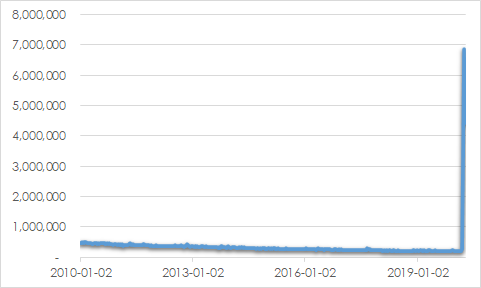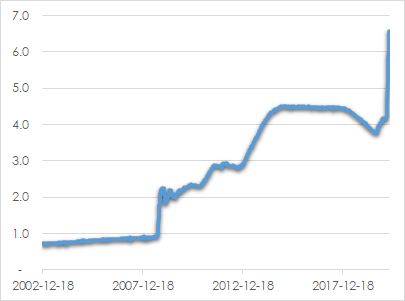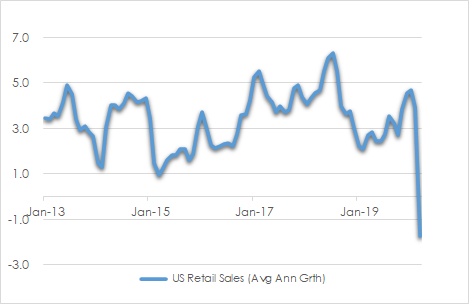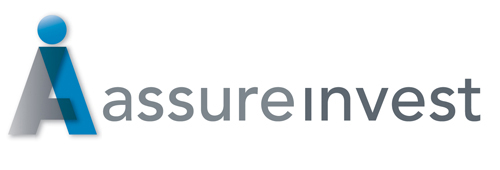Tragically, many lives continue to be lost to the coronavirus around the world. A brutal economic downturn is underway. The depth of the disaster and the speed of recovery will not be uniform across the globe. Advanced economies with stronger medical systems, administrative proficiency and funding capacity are likely do better.
The dramatic fall in purchase managers index data (PMIs) indicate the deep global recession that lies ahead. In the composite PMI for Europe for example which includes manufacturing and services fell to the lowest ever, 31.4 in March 2020 from 51.6 the previous month. Many small businesses are struggling to survive. The services sector, which represents the lion’s share of advanced nations’ activity, has been hit particularly hard. A wave of insolvencies by companies too indebted to stay afloat is likely to weigh on confidence. For both businesses and consumers, savings are rising sharply at the expense of discretionary spending.
Job losses have already been extraordinary and there are more to come. Over 26 million Americans filed initial unemployment claims in a five-week period from mid-March 2020. Companies are typically quick to lay off staff and then slow to reemploy until they are confident of revenue growth expectations. A high proportion of workers who have lost jobs are in relatively lower paid leisure & hospitality, retail and manufacturing sectors. They may be competing for new jobs against higher-skilled workers displaced from other sectors, so may be underutilised for an extended period. GDP growth is highly dependent on consumption, which is based on income, and this is likely to take an extended period to return to previous levels.
CHART 1: US INITIAL JOBLESS CLAIMS, WEEKLY

Source: US Dept of Labour
How quickly conditions will recover remains a critical question. Mercifully, social distancing and lockdowns are helping to moderate the number of new virus cases. This should allow activity to start to revive in the third quarter of this year. The recovery is likely to be gradual given the extent of bankruptcies, ability of the unemployed to find new work, and the need to unwind slowly the measures used to contain the virus for fear that control may once again be lost.
Governments were generally slow to introduce measures to contain the disease and so compensated by introducing harsher measures than they might have otherwise. Some of the actions are starting to be relaxed now. There remains the risk that new cases will rise again if containment measures are withdrawn too early. However those measures are unlikely to need to be as severe as the ones initially put in place.
The pace of recovery is likely to be varied across different zones, faster in regional areas than congested cities. Factories may reopen but it may take time before consumers regain confidence to spend as they did prior to the crisis. Services demand will be slowed by lingering uncertainty over the spread of the virus.
The speed and scale of the responses from central banks and governments have been impressive. The chances of a long-lasting depression have been reduced.
Central banks were quick to roll out programs developed during the global financial crisis, along with new ones, to help financial markets function properly and provide economic stimulus. As a result of asset purchases, the Fed’s balance sheet expanded by USD almost USD 2 trillion in the four weeks to 24 April 2020.
CHART 2: US FED BALANCE SHEET (USD TR)

Source: St Louis Fed
On the fiscal front, leading countries have acted swiftly with large scale programs to help as many people as possible avoid dire financial consequences. The policies help to buy time until solutions to the medical crisis are found, limit the damage, and assist the recovery. The plans have not been perfect, but they can be tweaked over time. Most businesses and infrastructure assets will be there when restrictions are lifted, and severe unemployment can then decline.
However, government spending may still not meet the challenges that various industries and people face. More stimulus is likely to be needed. US federal spending so far is clearly insufficient. The USD1,200 cheques sent to lower- and middle-income US families is unlikely to come close to repairing the damage that many unfortunately now face.
The coronavirus has significant longer-term macroeconomic implications. One of the immediate reactions has been a rethinking of global supply chains. The pandemic has highlighted the heavy reliance on China production at a time when international relations between China and western governments are increasingly strained. It is entirely conceivable that “deglobalisation” will proceed, particularly as it was already underway via trade wars and increased tariffs. While supply chain complexity may be reduced, there is the possibility of higher inflation and wages, even if demand is weaker, and this would weigh on corporate margins. In addition, health concerns may encourage governments to extend restrictions on trade, travel and migration. This will have a more enduring impact on businesses servicing these areas.
The pandemic appears to be accelerating the digitisation and automation of work and social practices. Services will continue to generate the bulk of advanced economy activity, but in time less will be provided face-to-face. Many lower skilled jobs in retail, healthcare, travel and education will be altered or made redundant.
Advanced economies have rapidly adapted to remote working and many businesses are likely to make adjustments to workflows more long lasting. Technology such as video conferencing is supporting work from home. The frequency of corporate travel and face-to-face meetings could be changed. The extended stay-at-home period is also accelerating the shift online of retailing and consumer experiences, resulting in lower attendance at shopping malls, movie theatres and fun parks. Altered use of roads and public transport has implications for urban development.
Uncertainties around household incomes will naturally encourage financial caution which has implications for discretionary spend. Debt levels will rise for many and the experience of lost income or unemployment will encourage greater savings. Many of us are getting used to getting by with less and therefore some may eat out less often or postpone purchases of cars and other more expensive items. US retail sales plummeted 6.3% in March 2020.
CHART 3: US RETAIL SALES

Source: St Louis Fed
Ultra-low interest rates are likely to persist for longer while governments will have greater involvement in the economy. Government debt jumped internationally after the global financial crisis and is now going higher. Monetary actions are required to ensure longer term borrowing rates stay low so that funding is available for growth. Concern over the independence of central banks is likely to rise in time. Possible overspending by governments in the aftermath of the crisis risks a sharper rise in inflation than is currently expected by markets.
Governments will need to prop up companies to support employment, but these may become excessively debt-laden or inefficient. Increased industry concentration as financially strong giants gobble up weak smaller ones could reduce the economy’s dynamism, particularly if the large firms become too intricately connected with governments. Higher longer-term tax levels to fund public debt repayment reduce companies’ ability to hire staff and invest in technology.
Investment Strategy
We have been increasingly cautious on the outlook for risk assets over the past several years and built up additional cash on hand to take advantage of intermittent selloffs. We modestly and selectively added to our Australian equity holdings during the steep selloff in mid-March 2020, favouring structurally advantaged enterprises with strong balance sheets likely to weather the chaotic conditions relatively well.
The recent share price rebound is welcome, but we are surprised by the extent of the move given the extremely uncertain outlook. Consensus has not yet full factored in the likely hit to earnings and dividends. The equity issuance cycle has only just begun.
There are likely to be better times ahead to increase equity, credit and real-estate positions. Share markets will be prone to significant further selloffs until there is clearer evidence that the health crisis is being resolved, individuals internationally are getting back to work and economies are rejuvenating. The recovery process will take time.
In the meantime, in our direct equities allocations we are worrying over the short term as a deep contraction is underway and it will take a while for conditions to approach anything close to normal. Survival depends on strong balance sheets and sustainable cash flows. But we are focused on the long term by seeking cases where market overreactions provide opportunities to buy outstanding companies offering outright fundamental value.
Government bonds have rallied since February and have less appeal on a longer-term perspective. We have some exposure to corporate credit but only to higher quality. Fundamentals in credit markets have deteriorated despite extraordinary monetary and fiscal accommodation. Borrowings will leap to offset the fall in revenue. Several companies face ratings downgrades. Better buying opportunities may present themselves as the crisis unfolds and sectors such as energy face significant challenges due to the collapse in the oil price.
We hope you and your families stay safe and healthy during this unusual time.
Andrew Doherty. AssureInvest
This article is provided as general information only and should not be construed as personal financial advice.

FREE Special Report: How to Jump ahead of competitors and add more value for clients
Learn how you can boost profits while enhancing customer outcomes.



